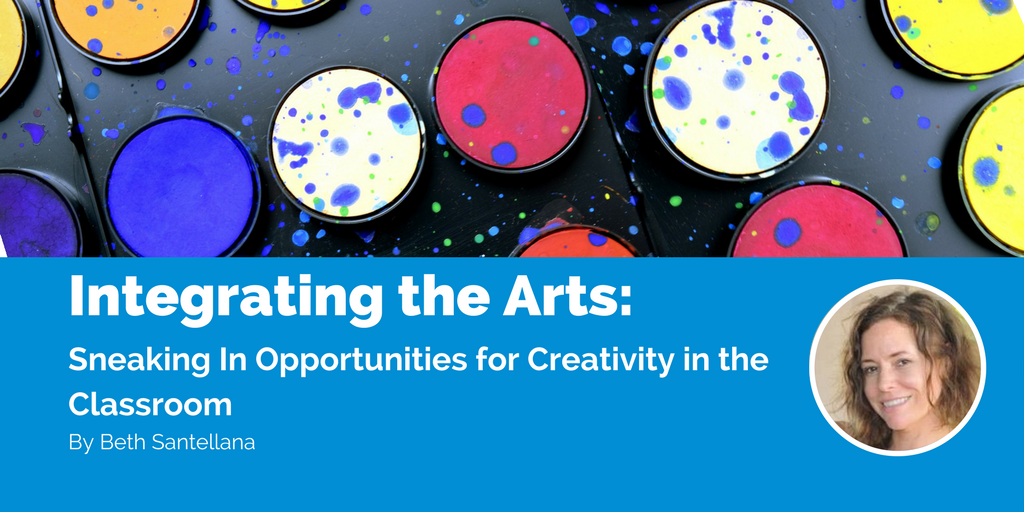
Integrating the Arts: Opportunities for Creativity in the Classroom
This Flocabulary community post comes from Beth Santellana, a third grade teacher and Flocabulary MC Educator, whose passion for integrating arts in the classroom is infectious.
“Without ART, the Earth is just EH”
Since you are reading this on Flocabulary’s blog, I think you already believe that we learn (and teach!) better when we are having fun. And few lessons are more fun than when we can use a Flocabulary video to get us singing the learning objectives (and shaking whatever body parts we feel comfortable with) to the beats. Perhaps you are also an academic core subject teacher who already uses art whenever possible in a lesson, because like the bumper sticker says, “Without ART the Earth is just EH.”
“Do it for the kids, the elders and the rap peers,
Q-Tip, “Vibes and Stuff”
We know the job is done when we hear a lot of cheers.
Gotta feel the vibes, real from my creation,
If the hands clap I’m filled with elation.”
But if you teach in a low-income public school, like I do, how do we do that when the bottom line is our students’ test scores? It’s not alarmist to say that most public school kids are in learning environments where it is completely normal to have absolutely no classes devoted to music, theater, or visual art.
I taught for seven years at a middle school in a city that calls itself the “Live Music Capital of the World,” but that motto did not apply for students who had unfortunately failed their standardized tests. Instead of elective classes where they might have experienced art, they doubled up on their core academic classes with remedial math and reading.
We as social beings crave the company of each other. Arts provide a close and safe connection to others. We don’t like being ignored. It feels bad. Not surprisingly, the middle school students I used to teach would subversively create their own art, from book/desk/restroom graffiti, to makeshift percussion instruments, to spontaneous sing-alongs (some even to me) when the mood would strike. And even though such behavior ultimately led to my frustration as their teacher, as a fellow human I had to admire their guerilla tactics as a demand for art.
New to Flocabulary? Teachers can sign up for a trial to access our lesson videos and assessment activities. Administrators can get in touch with us to learn more about unlocking the full power of Flocabulary through Flocabulary Plus.
Tips for Implementing the Arts
As a 3rd grade reading teacher in Houston ISD, I’m fortunate to have a principal who feels the same way I do: that art in school is a right and not a privilege. However, as a brand-new school in the district with no budget yet for an art, music, or theater teacher, I have taken it upon myself to make use of opportunities for my students to express themselves creatively.

Pair Writing Assignments With Drawing
Just before the holiday break, the 3rd grade presented biographies of famous inventors on displays of tri-folds for their parents to enjoy. Of course, they used research and fact-finding skills, but I was just as proud of their artistic renderings related to their projects, with drawings ranging from what their inventors looked like through the years, to the inventions that made them famous.
Also, I bought sets of alphabet stamps and ink pads so they could create special text for their project book covers. I am not taking any shortcuts that would have us avoid reading and writing, as I am just as passionate about literacy as I am for the arts. When students draw, it is always a supplement to what they write and not in lieu of a thoughtful written piece. But when it comes to putting best practices into place, nonlinguistic representations are a thing that even the most austere and aseptic of educators and administrators must accept.
Blend the Arts With Core Subjects for Family Engagement

Recently, at our school’s Math and Literacy festival, I set up a Flocabulary booth with 6 laptops, a portable file box packed with a range of Peach to Blue level Word Up! packets, a karaoke machine, and a pocket full of Flocabulary tattoos. We had a DIY spinning wheel with colors to help the youngest students choose a Flocabulary subject category while the older kids headed straight to the laptops to explore new and familiar Flocab favorites.
I offered the tattoos to only the students brave enough to perform the songs karaoke-style! Everyone left the table with a Flocabulary packet or other information.
Try Academic Songwriting for Content Mastery

If you haven’t already, check out Flocabulary’s outstanding new Lyric Lab feature to help your students write original rhymes using Flocabulary words from the unit! They’ll get to choose a fun beat from one of their favorite Flocabulary songs. Engage students to write academic rhymes as a creative way to demonstrate content mastery. And then it’s time to perform, which could be either the original songwriters or a volunteer rapper (both of which we’ve tried in my classroom).
The best thing about making the rhymes is that now the kids own the words. And they internalize the lessons from the videos, whether they were simply introducing meanings of new words, empowering them to have compassion, or strengthening academic concepts.
Start using Flocabulary
So go on, assign relevant drawings to develop your kids’ dendrites! And mix in media materials to motivate multidisciplinary musings! Add some drama to your lives with Reader’s Theater scripts. Or get up and dance to that next Flocabulary video! Remember, if you don’t plan the arts into your lesson, your students will. Why not enjoy them together?
New to Flocabulary? Teachers can sign up for a trial to access our lesson videos and assessment activities. Administrators can get in touch with us to learn more about unlocking the full power of Flocabulary through Flocabulary Plus.
